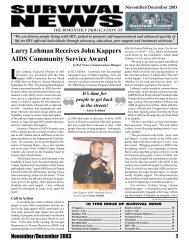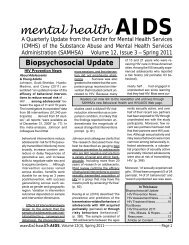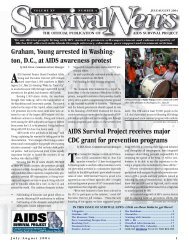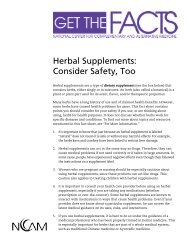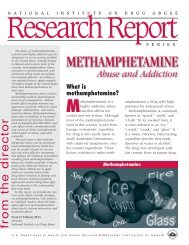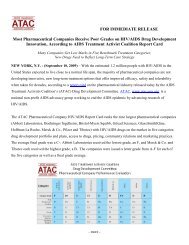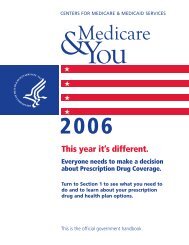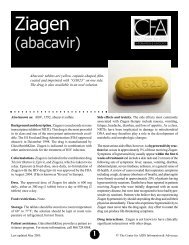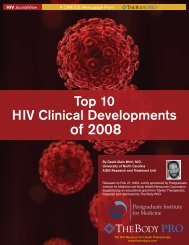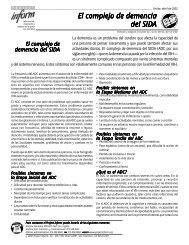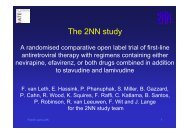The Positive Side (Winter 2013) - CD8 T cells - The Body
The Positive Side (Winter 2013) - CD8 T cells - The Body
The Positive Side (Winter 2013) - CD8 T cells - The Body
You also want an ePaper? Increase the reach of your titles
YUMPU automatically turns print PDFs into web optimized ePapers that Google loves.
time to prevent the virus from being<br />
transmitted to her daughter. <strong>The</strong>n<br />
Sage was hospitalized with pneumonia<br />
just days before her first birthday.<br />
“She was greyish purple and her life<br />
was leaving her body,” recalls Sage’s<br />
mom. An HIV test was requested and<br />
three weeks later, the family was<br />
shocked to learn that Sage and her<br />
mom were HIV positive, and that her<br />
mom had seroconverted while pregnant.<br />
It is cases like Sage’s that lead<br />
some advocates to call for ongoing<br />
testing during pregnancy.<br />
sAGe, wHo HAs remAineD stAble<br />
on her first regimen of Kaletra<br />
(lopinavir/ritonavir) and Combivir (AZT/3TC), says, “I have<br />
taken meds my whole life…I don’t like taking them because<br />
they make me feel like I’m going to barf.” She copes by<br />
drinking lots of water. She admits that sometimes she forgets<br />
to take her meds, but her mom reminds her. Now in<br />
grade 5, Sage is already a strong advocate for her own<br />
health care: “I want them [the meds] changed to something<br />
that won’t upset my stomach. I’m going to tell the doctor.”<br />
Like Sage, 19-year-old Josh began taking antiretroviral<br />
therapy before his second birthday. Whereas Sage was born<br />
in the era of combination antiretroviral therapy (ART) and<br />
has not developed drug resistance, Josh was born early in<br />
the epidemic, when AZT monotherapy and other less potent<br />
therapies were the only options. “<strong>The</strong>re were a lot of pills,<br />
they were hard to swallow and they tasted bad,” he recalls of<br />
some of the more difficult-to-take early treatment regimens.<br />
As a result, his HIV is resistant to two classes of drugs, nukes<br />
(NRTIs) and non-nukes (NNRTIs). Now a young man, he has<br />
faced serious challenges with medication.<br />
Josh has also encountered disclosure dilemmas when it<br />
comes to his meds. When he was 10, he wanted to have<br />
sleepovers with his friends. Although he was able to do this,<br />
he had to make sure he either took his pills before leaving<br />
home or packed them in a bottle and discreetly took them<br />
with water from the tap while he brushed his teeth. “Other<br />
people never asked questions because<br />
no one ever saw me take my meds,”<br />
he says. “I kept it really low-key.”<br />
In the recent past, “pill fatigue,” a<br />
desire to avoid revealing his meds at<br />
work and partying contributed to a<br />
less-than-perfect adherence record.<br />
“It made me feel more normal and in<br />
control of my life to not take them,”<br />
Josh says. “It’s hard to drink alcohol<br />
and take HIV meds.” His inconsistency<br />
with taking meds created serious<br />
health problems, including a low CD4<br />
count, an increasing viral load and a<br />
low platelet count. “I didn’t know it<br />
16 THE POSITIVE SIDE <strong>Winter</strong> <strong>2013</strong><br />
“Mom, yOu have<br />
nO idea what<br />
It is like tO be<br />
a teenager<br />
with HIV.”<br />
If you are the parent of an HIVpositive<br />
child and you’re looking for<br />
more info, check out Chapter 16<br />
from Managing Your Health on<br />
“Children and HIV.” It looks at how<br />
HIV affects children differently, steps<br />
to take to keep HIV-positive children<br />
healthy and how to talk to kids<br />
about HIV at different ages. View<br />
the chapter online (at www.catie.ca)<br />
or order a free copy of the guide<br />
through CATIE’s Ordering Centre<br />
(www.catie.ca or 1.800.263.1638).<br />
was killing me to not take them,” he<br />
says in retrospect. More recently,<br />
Josh switched to taking his pills once<br />
daily. Because this is relatively easy,<br />
his adherence has improved, his CD4<br />
count has increased and his viral<br />
load is now suppressed. At 19, Josh’s<br />
options for HIV therapy are limited,<br />
emphasizing the need to discover<br />
new ways to treat HIV.<br />
A budding advocate for youth living<br />
with HIV, Josh joined a panel of<br />
experts at the International AIDS Conference<br />
held in Washington, DC, in<br />
July 2012, to discuss his life growing<br />
up with the virus. Studies presented<br />
during this session indicate that there<br />
may be some adverse effects of ART on growing children. Dr.<br />
Jason Brophy, a pediatric infectious diseases specialist at<br />
Ottawa’s Children’s Hospital of Eastern Ontario, agrees and<br />
is currently conducting studies to look for kidney and bone<br />
health problems and treatments for high lipids among his<br />
young patients. Some studies have shown that among children<br />
living with HIV, there is a higher incidence of delayed<br />
motor and language skills and attention deficit disorder<br />
(ADD). Other studies have shown that many adolescents with<br />
HIV experience depression and other mental health issues.<br />
During his session in Washington, Josh described how<br />
the learning disability dysgraphia (a deficiency in the ability<br />
to write) and ADD have been issues in his life. He rhetorically<br />
asked fellow panelists: “What causes these problems: HIV or<br />
the meds?” His query was astute; it’s exactly what<br />
researchers hope to answer regarding the mental health and<br />
physical and cognitive development of growing children.<br />
Despite these health issues and the fact that children can<br />
be quite ill when initially diagnosed, Dr. Brophy says that<br />
once they are in care and on treatment when it’s deemed<br />
necessary, “the vast majority of children with HIV in Canada<br />
are the picture of health.”<br />
As sCienCe Continues to look For Answers to some of<br />
these issues, life goes on for children growing up with HIV.<br />
Both Sage and Josh have known<br />
about their HIV status from an early<br />
age and both are still learning about<br />
how HIV affects them at different<br />
stages of their lives, how to handle<br />
secrets and how to manage their<br />
health and emotions along the way. “I<br />
have known all my life that I have<br />
HIV,” Josh says. “But I didn’t really<br />
know what it meant until I was about<br />
13. That’s when I learned that HIV was<br />
an STI (sexually transmitted infection),<br />
and that I had an STI, and I hadn’t<br />
even had sex yet.” Josh describes the<br />
proverbial sex talk as “not the average




